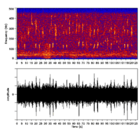Engineering:Synthetic aperture sonar

Synthetic aperture sonar (SAS) is a form of sonar in which sophisticated post-processing of sonar data is used in ways closely analogous to synthetic aperture radar. Synthetic aperture sonars combine a number of acoustic pings to form an image with much higher along-track resolution than conventional sonars. The along-track resolution can approach half the length of one sonar element, though is downward limited by 1/4 wavelength. The principle of synthetic aperture sonar is to move the sonar while illuminating the same spot on the sea floor with several pings. When moving along a straight line, those pings that have the image position within the beamwidth constitute the synthetic array. By coherent reorganization of the data from all the pings, a synthetic aperture image is produced with improved along-track resolution. In contrast to conventional side-scan sonar, SAS processing provides range-independent along-track resolution. At maximum range the resolution can be magnitudes better than that of side-scan sonars.
A 2013 technology review [1] with examples and future trends is also available. For academics, the IEEE Journal of Oceanic Engineering article: Synthetic Aperture Sonar, A Review of Current Status[2] gives an overview of the history and an extensive list of references for the community achievements up to 2009.
See also
- beamforming
- phased array
- side-scan sonar
- sonar
- underwater acoustics
References
- ↑ R. E. Hansen, Synthetic Aperture Sonar Technology Review, Marine Technology Society Journal, Volume 47, Number 5, September/October 2013, pp. 117-127 [1]
- ↑ M. P. Hayes and P. T. Gough, Synthetic Aperture Sonar: A Review of Current Status, IEEE J. Ocean. Eng., vol. 34, no. 3, pp. 207-224, July 2009. Access abstract.
External links
- KRAKEN MINSAS for AUV's
- KRAKEN INSAS for AUV's
- KRAKEN Actively Stabilized SAS Towfish - KATFISH
- iXBlue - SAMS-DT6000
- Kongsberg - Hisas
- Raytheon Applied Signal Technology - HD Sonar


